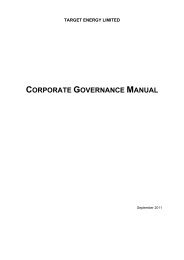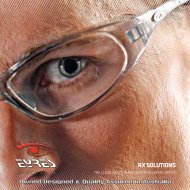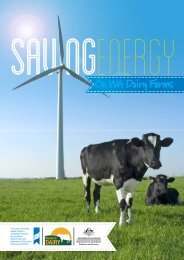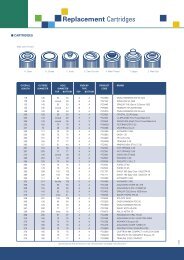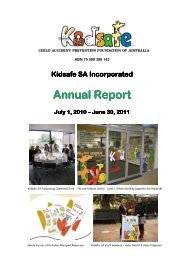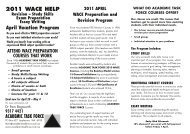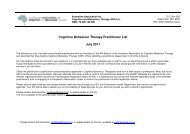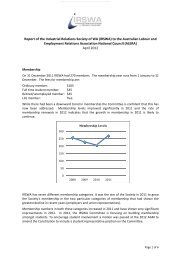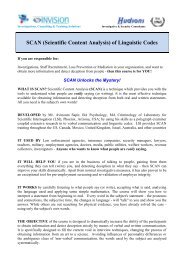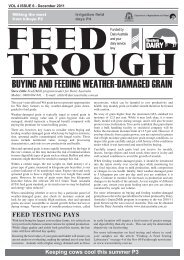Scalds
Scalds
Scalds
You also want an ePaper? Increase the reach of your titles
YUMPU automatically turns print PDFs into web optimized ePapers that Google loves.
Hot Food and Drink <strong>Scalds</strong><br />
Hot drink scalds usually involve a young child pulling a<br />
cup down on themselves; pulling down on an item (e.g. a<br />
tablecloth) that causes a drink to fall; or running into/being<br />
held by someone who has a drink and spills it. Children<br />
aged one to two years are most likely to be scalded in this<br />
way.<br />
Injuries are usually to the head, face, chest and hands.<br />
Hot drink scalds can happen quickly, often with adults<br />
nearby who do not realise a child is reaching for the hot<br />
drink until it is too late to stop them.<br />
To a small child the home is full of exciting things to touch,<br />
grab and climb. Children may grab hot cups, kettles, pots,<br />
pans and taps. They do not know that hot water burns like<br />
fire and can scar for life.<br />
You can stop your child from being scalded by watching<br />
them and by making some simple changes in the home.<br />
Kettles<br />
Keep kettles, jugs, teapots, coffee plungers and<br />
cords away from the edge of the bench.<br />
Use a cordless kettle.<br />
Buy a curly electric cord or tie your kettle cord out of<br />
reach of children.<br />
Hot Drinks<br />
Put hot drinks in the centre of the dinner table or<br />
somewhere else out of reach.<br />
Use non-slip place mats instead of table cloths<br />
Give toddlers their own special mug so they do not<br />
drink from yours<br />
Use broad-based commuter mugs with a lid<br />
Put your child down before having a hot drink<br />
Pots and Pans<br />
Keep young children out of the kitchen while cooking<br />
Fit a gate across your kitchen doorway<br />
Place children in a playpen<br />
Put your child down before using hot pots, pans and<br />
kettles<br />
Place microwaves at a safe height. The user’s face<br />
should be higher than the door.<br />
Fit a stove guard around your stove top.<br />
Use back hot plates before the front ones.<br />
Turn pot handles away from the front of the stove or<br />
bench.<br />
<strong>Scalds</strong> Facts<br />
Hot water can scald for up to 30 minutes after it<br />
is boiled. A fresh, piping hot drink can scald in a<br />
second.<br />
A cup of hot liquid spilled over a baby or toddler<br />
is equivalent to a bucket of hot water being<br />
spilled over an adult.<br />
First Aid for <strong>Scalds</strong><br />
1. Remove wet clothes. This helps the heat to escape<br />
from the skin. Leave clothing on if stuck to the skin<br />
2. Immediately apply lots of cool water to the scald<br />
for 20 minutes. Do not use ice or ice water: it will<br />
damage the skin<br />
3. Keep the child warm. This will help to prevent the<br />
child from going into shock.<br />
4. See a doctor if the scald is:<br />
On the face, hands, feet, genitals or buttocks<br />
Larger than a 20c coin or blistered<br />
In an emergency phone 000 for an ambulance<br />
The Queensland Government has a brochure called Hot<br />
Water Burns Like Fire. To view, click on the following<br />
link:<br />
www.health.qld.gov.au/phs/documents/tphun/28207.pdf<br />
*Figures extrapolated from data provided by QISU 2006<br />
Information reproduced with permission of Kidsafe WA.<br />
Kidsafe QLD © 2006<br />
Excerpts may be copied for educational purposes. Written permission<br />
is required to copy this fact sheet in its entirety.<br />
For more information (07) 3854 1829<br />
Email: qld@kidsafe.org.au<br />
Website: www.kidsafeqld.com.au



